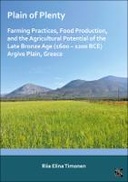Explore

<p>The Argive Plain in the northeastern Peloponnese, Greece, was central to the Mycenaean culture during the Late Bronze Age (ca. 1600–1200 BCE). While known for its settlements and treasures, little is understood about its agricultural sustainability. This study examines Mycenaean farming in the Argive Plain and its societal implications, investigating if resource depletion contributed to the Bronze Age collapse.</p><p><br></p><p>Using agricultural potential modelling, it reconstructs farming practices within the region’s political hierarchy, assessing sustainability through food consumption, energy needs, and land usage. Results indicate sustainable agriculture despite challenges like drought. However, ruling elites’ additional production needs may have strained resources. The thesis also addresses estimations of Neolithic and Bronze Age Aegean subsistence space, highlighting the overlooked impact of livestock on agricultural potential. By incorporating dairy and meat production, future models can better represent food production and environmental sustainability.</p><p><br></p><p>This research enhances understanding of Mycenaean agricultural practices before the Bronze Age collapse, illustrating how elite formation likely influenced local communities and broader society.</p>
This book is included in DOAB.
Why read this book? Have your say.
You must be logged in to comment.
Rights Information
Are you the author or publisher of this work? If so, you can claim it as yours by registering as an Unglue.it rights holder.Downloads
This work has been downloaded 7 times via unglue.it ebook links.
- 7 - pdf (CC BY-NC-ND) at OAPEN Library.
Keywords
- Archaeology
- Humanities
- Social Science
Links
DOI: 10.32028/9781803278551Editions

